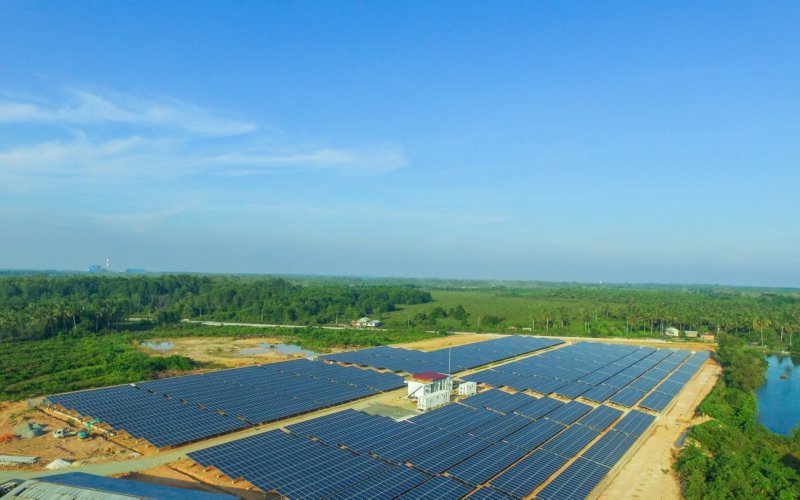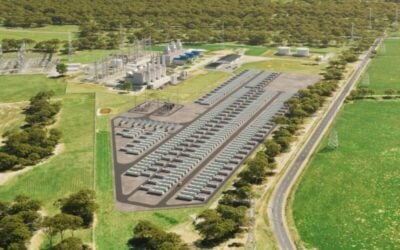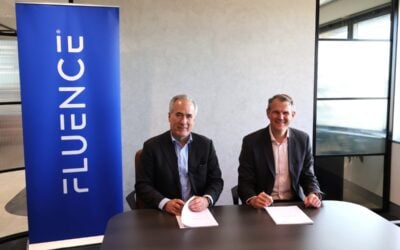
Hitachi ABB Power Grids will supply battery energy storage and smart controls to Singapore’s first virtual power plant (VPP), on a project aimed at validating methods for integrating more renewable energy onto the city-state’s electricity networks.
The project will help integrate electricity from different distributed energy resources (DERs) including solar in a way that simulates the workings of a utility-scale power system, the company said. Hitachi ABB Power Grids will provide its Powerstore battery storage technology coupled with the company’s digital controls platform, called e-mesh.
Enjoy 12 months of exclusive analysis
- Regular insight and analysis of the industry’s biggest developments
- In-depth interviews with the industry’s leading figures
- Annual digital subscription to the PV Tech Power journal
- Discounts on Solar Media’s portfolio of events, in-person and virtual
Virtual power plants which combine large numbers of distributed assets from behind-the-meter including rooftop solar, battery storage and other assets like electric vehicles and smart thermostats to form a much larger, aggregated resource that can serve energy or power functions on the grid have been growing in number around the world, with notably large examples already deployed in Australia, the US, Japan and elsewhere.
The new project, which began its development process a couple of years ago, is however a first for Singapore, which only got its first large-scale battery storage system last year, a 2.4MW / 2.4MWh energy storage system (ESS) installed by Wärtsilä in a project supported by the Singapore Energy Market Authority (EMA).
The battery storage and controls will balance variable generation from DERs with “smart and dynamic loads”, the company said in a press release. A representative told Energy-Storage.news that details of storage output and capacity, or of the distributed energy resources to be integrated, could not be revealed at this time.
The Hitachi ABB Power Grids representative did say in a brief statement that the e-mesh Powerstore combination is “a scalable microgrids and energy storage solution that is designed to ensure reliable power availability, grid stability, highest possible penetration of renewable energy together with an intelligent control system for both grid-connected and off-grid systems”.
“This project demonstrates the innovation driving entirely new approaches to electrification. VPPs are a flexible, reliable addition to the infrastructure already in place to shift to even more renewable sources of energy,” the representative said.
The project is being developed by Nanyang Technological University, Singapore’s Energy Research Institute and is jointly funded by Singapore’s Energy Market Authority (EMA) and engineering services company Sembcorp, which is also headquartered in the country.
Hitachi ABB Power Grids country managing director for Singapore, Nirupa Chander, said that Singapore has one of the most reliable electricity networks in the world and that the project was a good example of how multiple stakeholders from government, academia, industry and technology providers “collaborate to deliver innovative solutions and accelerate the energy transition for a greener future”.
“To meet the carbon emission standards of the future, Singapore will have to tap on all renewable energy sources, relying on artificial intelligence and smart solutions to better coordinate and manage all its energy sources efficiently. The Virtual Power Plant (VPP) is a key project that will allow efficient modelling and innovative features of these emerging technologies to be validated,” Nanyang Technological University professor Lam Khin Yong said.
In a recent interview with Energy-Storage.news, Hitachi ABB Power Grids head of grid edge solutions, Maxine Ghavi, talked about how how optimising and balancing distributed energy resources has become more complex in recent years, requiring higher levels of sophisticated technology and digital control platforms.
Southeast Asia’s largest solar microgrid is at a coal mine
While that project is hoped to point the way forwards for a greener future in Singapore, elsewhere in Southeast Asia Hitachi ABB Power Grids announced that work has been completed on what has been claimed as the largest microgrid project on the sub-continent that integrates solar power — located at a coal mine.
The mine is an off-grid site in East Kalimantan, Indonesia, operated by mining company Indo Tambangraya Megah (ITM). While it produces around 12.5 MT of coal annually, the new microgrid will combine 3MWp of solar PV, 2MW / 2MWh of Hitachi ABB Power Grids Powerstore battery storage and the company’s e-mesh control system and SCADA with existing diesel gensets and 14MW of existing steam turbine generators to reduce the mine’s carbon footprint by up to 192 tonnes.
Hitachi ABB Power Grids’ local subsidiary PT ABB Power Grids Indonesia deployed what is thought to be the first microgrid in the country to ensure continuous power supply for off-grid mining. The project was actually completed in 2019 and started operations in 2020 but Hitachi ABB Power Grids chose to announce it this week via a press release.
“Hitachi ABB Power Grids is proud to partner with ITM in their goal to achieve industry-leading sustainable operations. Remote locations like Bontang, East Kalimantan are rich in renewable energy sources, but their intermittent nature makes integration into the power grid a challenge,” Hitachi ABB Power Grids managing director for grid automation said.
“This project shows how the successful integration of solar PV with PowerStore dramatically reduces fuel consumption and carbon emissions to drive energy efficiency and sustainable growth.”






